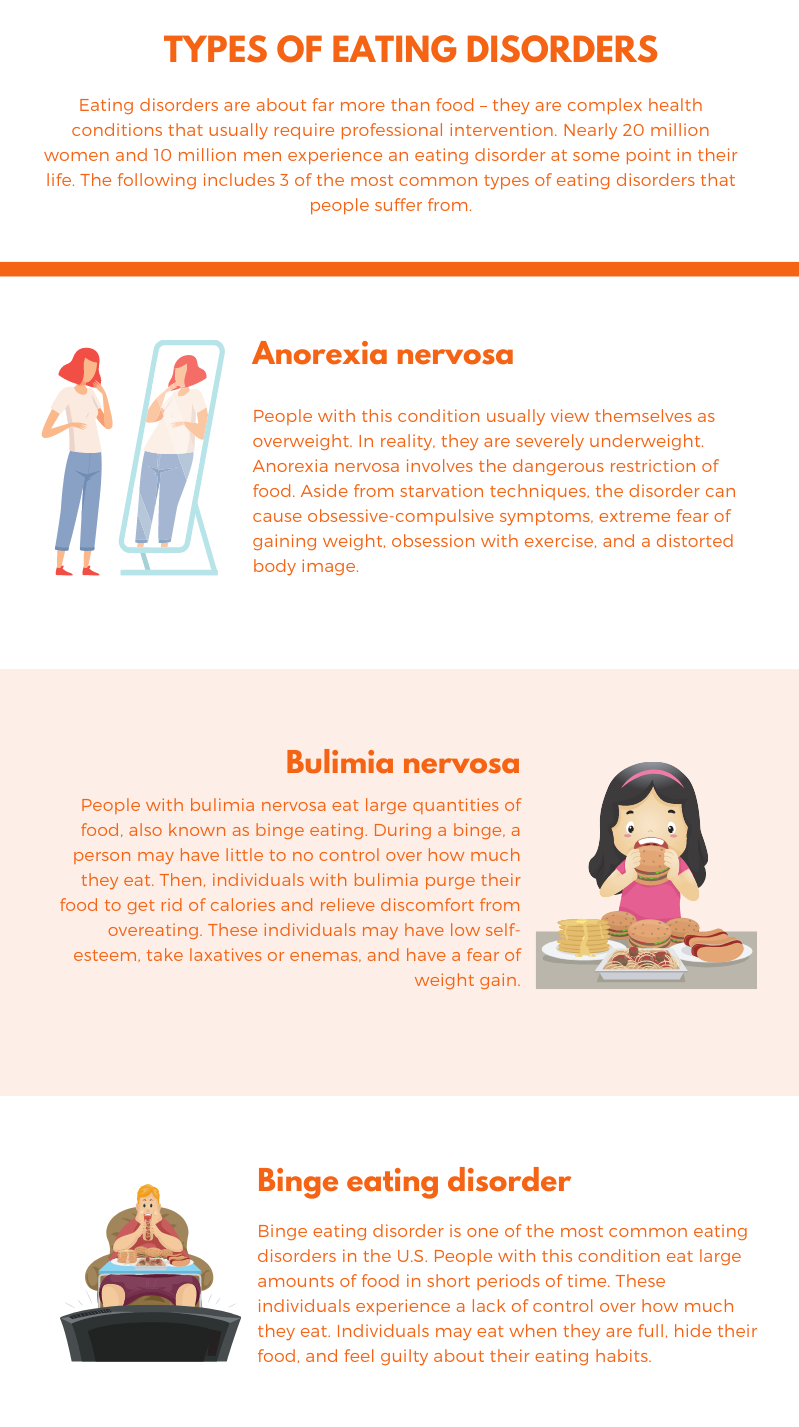The Only Guide for Eating Disorder Recovery
Wiki Article
Everything about Eating Disorder Recovery
Table of ContentsSome Ideas on Eating Disorder Recovery You Need To KnowEating Disorder Recovery Things To Know Before You Get ThisAn Unbiased View of Eating Disorder RecoveryThe Only Guide for Eating Disorder RecoveryEating Disorder Recovery Things To Know Before You Get This

ARFID is usually taken into consideration a severe type of picky eating. Some children are picky eaters and can be identified with ARFID because they do not consume adequate calories to establish and expand. Adults can be detected with ARFID as well, and also along with not developing literally, they may have difficulty with keeping standard bodily functions.
Rumination condition is an eating condition that entails regularly throwing up food. As soon as thrown up, the food may be re-chewed, re-swallowed or spew out. Somebody with rumination problem doesn't show up to do this purposefully. A person with rumination problem is also unlikely to show up distressed, distressed or ashamed by their frequent regurgitation.
Not known Factual Statements About Eating Disorder Recovery
People who are diagnosed with rumination eating condition are regularly educated to replace the regurgitation with deep breathing methods. Orthorexia nervosa is not yet an identified consuming condition diagnosis.Orthorexia is specified as a fascination with eating healthy and balanced food as well as avoiding harmful food. An individual with orthorexia is likely to experience some disabilities in their life due to their obsession with healthy and balanced eating.
Like orthorexia, diabulimia is not yet an officially acknowledged eating problem. Comprehending specifically what diabulimia is can help determine individuals who are battling with this problem and might additionally be at threat of developing various other eating disorders.
Eating Disorder Recovery Fundamentals Explained
, was formerly understood as Eating Disorder Not Or Else Defined (EDNOS). An OSFED eating disorder might not meet the diagnostic standards for various other eating disorders but is nonetheless serious and possibly serious.An individual with an OSFED is equally as likely to have significant clinical repercussions as individuals that completely fit an eating disorder medical diagnosis. Somebody that has an OSFED might be equally as most likely to die as an outcome of disordered consuming as anybody else with an eating disorder. Consuming conditions may be brought on by co-occurring psychological health and wellness disorders and also can trigger physical conditions that can be life-threatening.
Identifying the early caution indicators of eating problems can make an incredible difference in the lasting health and wellness results created by the condition. Signs and signs of consuming conditions can be typically separated right into two sub-categories: behavior (as well as emotional) indicators and physical indicators. Typical psychological as well as behavioral indicators of an eating disorder may not constantly be easily identifiable.
6 Easy Facts About Eating Disorder Recovery Shown

In circumstances where typical behavior and also psychological symptoms are unable to be observed, a physician might identify an eating problem only based upon physical signs (eating disorder recovery). Some usual physical signs of an eating condition consist of: Obvious changes in weight (both gains as well as losses)Tummy aches, Constipation, Acid reflux, Menstrual abnormalities, consisting of loss of durations or missed periods, Difficulty concentrating or sustaining attention, Wooziness or fainting, especially after standing, Resting troubles, Cuts and calluses on fingers, Dental troubles like enamel disintegration, dental caries and also tooth level of sensitivity, Dry Website skin, hair as well as nails Like other psychological wellness problems, eating disorders are brought on by a mix of environmental, genetic and also social aspects.
For instance, a dysfunctional hormone feedback to anxiety may recommend a sensitivity to establishing an eating disorder. Social scenarios linked with sporting activities, modeling or other occupations focusing on body picture and weight control can affect the advancement of eating conditions. The National Alliance on Mental Ailment records that individuals are much more most likely to create an eating condition if one of their immediate family members has one.
What Does Eating Disorder Recovery Mean?
Warning indications vary from person to person, however some variables are likely to influence an individual's danger of creating an eating disorder (eating disorder recovery). Some organic danger variables that are appropriate to individuals with anorexia nervosa, bulimia nervosa or binge eating problem include: Having a relative with an eating disorder, Having a member of the family with an additional mental health problem Perfectionism, Body image frustration, History of an stress and anxiety conditionStiff thinking Weight stigma, Background of weight loss, Being teased or bullied, Limited social networks, History of trauma Similar to other psychological wellness disorders, eating disorders and also addictions frequently co-occur.In addition, as much as 35 percent of individuals with substance usage conditions additionally had an eating condition. The most typical materials abused by people with an eating disorder consist of: Continue Alcohol, Laxatives, Emetics, Diuretics, Amphetamines, Heroin, Drug A lot of these substances are understood for their appetite-suppressing adverse effects. Dual medical diagnosis of consuming conditions and also drug abuse requires thorough therapy for both conditions.
Report this wiki page